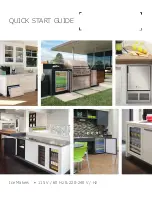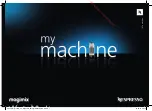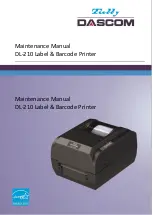
16
®
X2 Home Pos: X2 Home is used on all machines, and is
the only home reference for single motor X drive machines
(M9200 with torque tube). Like X1 Home Pos, X2 is an offset
in cm. from the X axis home switch. Set this number to
where you want your table origin to be.
Y Home Pos: Works the same way as the X Home offsets,
but for the Y-axis. You may wish to adjust Y Home Pos for
different material widths or wear on the table surface.
Home Vel: Maximum speed of the machine during the hom-
ing sequence. This should always be a relatively slow speed.
Home Acc: Acceleration in G’s used for the homing se-
quence.
Z Search: Maximum number of radians allowed to search
for the Z Home sensor. (9 radians is approximately one and
a half rotations.) This number may be negative or positive,
depending which direction you want the motor to spin dur-
ing its search. Note: If for any reason you change the search
direction, the Z offset must be recalibrated for each tool in
the Machine Setting Spindles window.
Table Left: Limits the travel of the machine to your left as
you face the operator keypad. If your system includes an
Easipull gripper, the Table Left limit must allow for travel
beyond the home switches. This means that your Table Left
limit will be a negative number. Take care that the Table Left
number allows sufficient travel for the gripper to reach the
material, but also stops travel before the machine’s X axis
limit switch is clicked. Specified in cm. Jogging the ma-
chine with the joystick is a good way to determine the cor-
rect number.
Table Right: Operates the same way as the Table Left set-
ting, but down the table to the right. This number should be
set to allow the furthest travel down the table without acti-
vating the machine’s X-axis limit switch. Also specified in
cm.
Table Bottom: Limits the travel of the Y car towards the
operator side of the table. Again, this must be set so that
the machine does not click its Y axis limit switch.
Table Top: Works on the far side of the table for the Y-axis.
Set Table Top to stop the machine’s travel before it clicks its
limit switch. Jog the machine to help find the appropriate
setting.
The Machine Setting VFO screen.
Loop Delay: Adjusts the amount of noise filtering applied
to the keypad. This is necessary as electrical noise can
create signals to the computer, causing the machine to crash
or move by itself. To prevent this problem, the Loop Delay
specifies how many samples to average together to deter-
mine if a keypad command has been given. If the Loop De-
lay is set too low, electrical noise may cause false input
from the keypad to be read by the computer. If set too high,
the plotter will take longer to respond to the operator’s key-
pad commands. This variable is set at the factory. Do not
under any circumstance change it without consulting East-
man Technology Systems Technical Support.
Update Interval: Specifies the time interval at which the
computer updates the velocity command to the motors. If
this interval is too short, the computer will not be able to
calculate and load the next velocity, resulting in a ?VFO
COUNT ERROR? message. A 33 MHz 486 computer should
use an update interval of 0.002. Slower computers such as
a 386 require a larger interval. If this number needs to be set
to .01 or greater to prevent the error, it is likely that some-
thing else is wrong.
VFO Bits:
This number is used to calculate the proper factor for con-
trolling the frequency divider on the VFO board. This is usu-
ally set to 19. Do not change the VFO bits without consult-
ing Eastman Technology Technical Support.
Bus Clock: The input frequency to the VFO board is the PC
bus clock. This should be set to 14.318. The computer uses
this number to keep time, so changing it would cause inac-
curacy in cutting velocity. Do not change this number with-
out consulting Eastman Technology Technical Support.
Содержание ETS-SLS-2
Страница 1: ......
Страница 24: ...24 Notes ...
Страница 25: ...25 Notes ...
Страница 26: ...26 Notes ...
Страница 28: ......













































